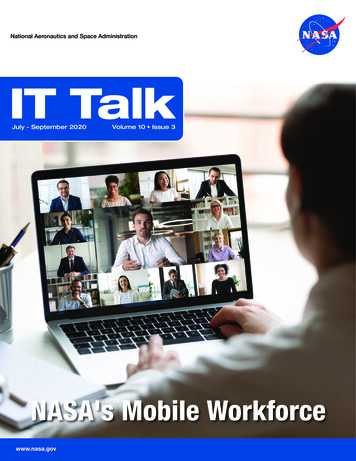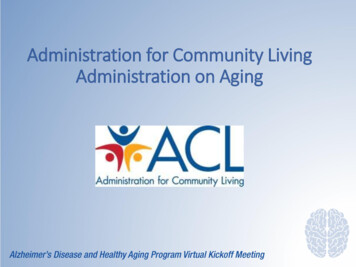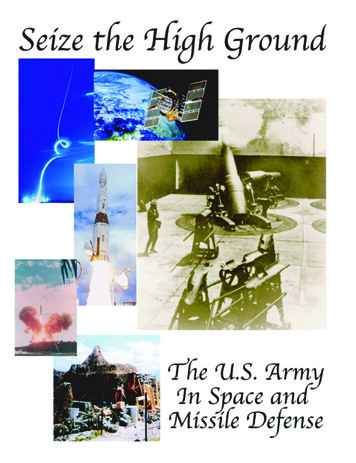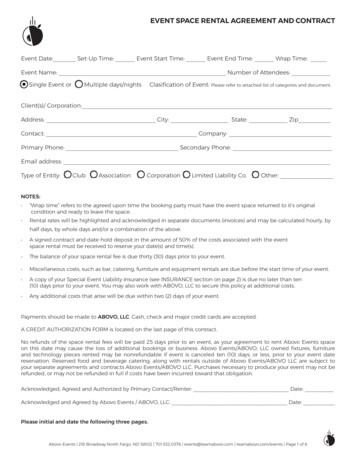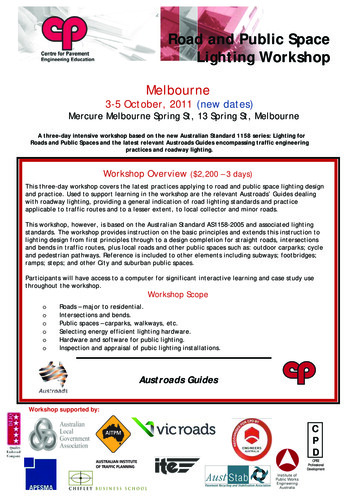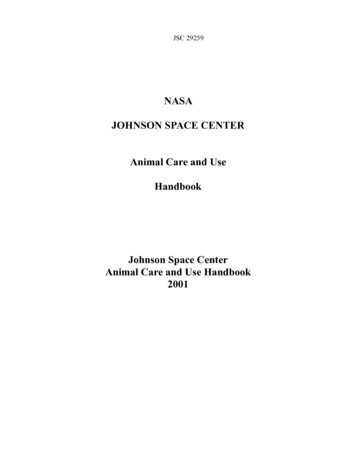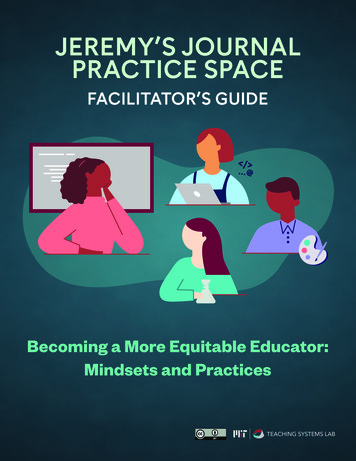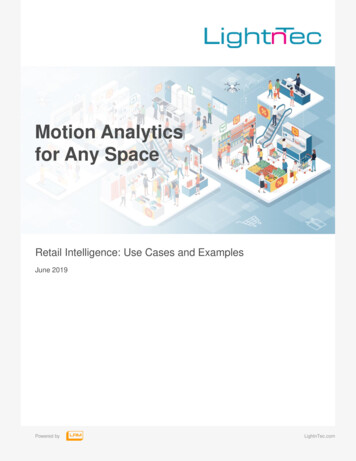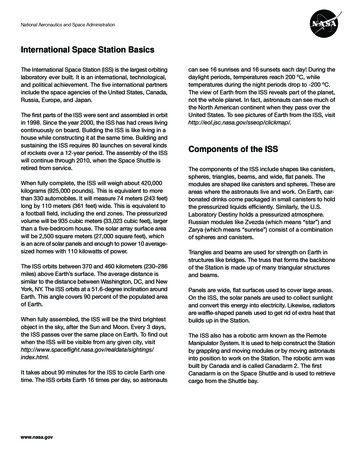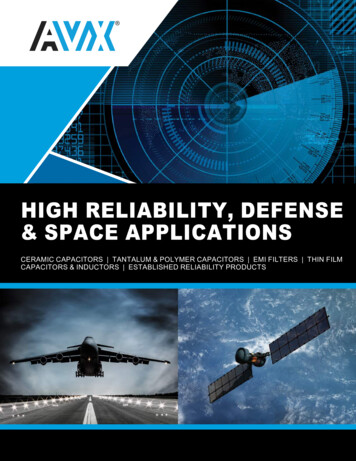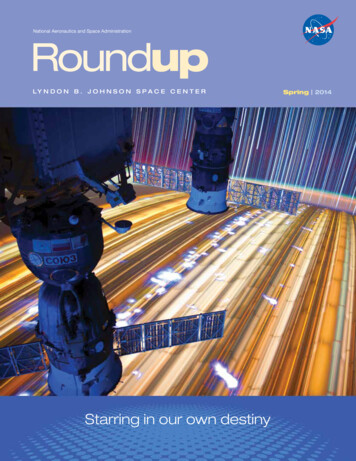
Transcription
National Aeronautics and Space AdministrationRoundupLY N D O N B . J O H N S O N S P A C E C E N T E RStarring in our own destinySpring 2014
Guest ColumnISS Science Corner4Mission Operations preparesto take the helm of the Orionspacecraft5Commercial Crew begins2014 by meeting milestones6The pressures of confinementbring NASA one step closer toan asteroid mission8Welcome home, Expedition38; and Commercial Crewbegins 2014 by meetingmilestones cont.9JSC, up close and personal—through the power of the lens10Meet Wendy Watkins, ProjectCoordinator/Education andPublic Outreach Specialist11Center Scoop12JSC, up close and personal—through the power of thelens cont.NASA/PHOTO3On the cover:This image of documenting anExpedition 31 star trail compositewas featured in the NASA:Through Our Eyes exhibit (moreon page 9). Docked Soyuz andProgress spacecraft are alsovisible.MOST OF YOU BY NOW have heard us talk about Johnson Space Center 2.0and the need to find new ways to advance human spaceflight. Making surewe are effectively tapping into all available talent is key to our success in thatendeavor. Over the past several years, we’ve been stressing the link betweeninclusion and innovation. We’ve learned that bringing together people withdiverse backgrounds, experiences and perspectives to work on our complexproblems inevitably results in better solutions. Being inclusive means muchmore than just treating people with equality, regardless of their age, gender,ethnicity, sexual preference or spiritual beliefs. At its core, being inclusiveis about helping others succeed so that the team can succeed. Part of beinginclusive is about making sure management approaches we use don’t causeus to overlook potential leaders.In the spirit of JSC 2.0, at the start of this year, we began a new pilotprogram called the Transparent Opportunities Pilot (TOP). DesignedMelanie Saundersto enhance employee engagement, increase transparency and employeeAssociate Director (Management)awareness of career development opportunities and strengthen our “bench,”TOP aims to help supervisors and employees alike discover hidden talents and leadership opportunities withinparticipating organizations.Some organizations, such as Procurement, Legal, Office of the Chief Financial Officer and Safety and MissionAssurance, are “all in” on the pilot program, while larger organizations, such as Engineering and Human Healthand Performance, have major divisions participating. All told, some 675 civil service employees, or about 23percent of the JSC civil service population, will participate in TOP this year. Each of these organizations willdefine and track “opportunities” and customize TOP for their own use, but they’ll all discuss best practices andparticipate in analyzing our level of success as a center when we look at whether the concept can be appliedthroughout JSC.So why is this necessary? We’ve all seen the situation—a challenging task crops up. Maybe it’s a tiger teamor a rotation or a chance to work on a center or agency team, or make a high-profile presentation to a centeror program board. These opportunities can provide great experience and get you noticed. Who gets theseassignments? In the past, supervisors would frequently turn to someone who had successfully demonstrated takingon challenging assignments. That seems reasonable and is a natural tendency—supervisors have a lot on theirplates, and it is often said that the first-line supervisors have the hardest job in the agency. It is easy to understandwhy a leader would turn to team members who have typically been strong performers. But in just assigning the taskwithout asking who is interested, they may have overlooked others who were equally skilled or had the potentialto be successful because they brought a new perspective. Someone else in the organization may be just as talentedor just as hungry to grow and learn, but they may not have been chosen in the past for a variety of reasons. (Maybethey were waiting to be asked, or maybe they assumed the supervisor had a few favorite go-to people and wouldn’twelcome a volunteer.) I know from experience that, most of the time, the supervisor is just trying to get the workdone and wants someone to get started on it.TOP is a commitment by participating managers to actively solicit volunteers for these “stretch assignments” sothat anyone willing may embrace a challenging task that allows the employee to develop new skills or demonstratepreviously hidden talents. This allows supervisors to be more inclusive in helping team members develop their ownskills and talents, makes employees more valuable to the team and the team itself stronger, more capable and morevaluable to NASA.Part of the TOP strategy is to share the experiences of participating organizations with the rest of the centerso that everyone can benefit. So, keep your eyes and ears open. When someone asks you if you’re up for a newchallenge, try not to think about the extra work it might entail but about the potential benefits to you, yourcareer and your center when you succeed. It is going to take all of us working at full speed to advance humanspaceflight. If you are looking to advance human spaceflight and your career, look for TOP opportunities and raiseyour hand!2 Roundup LYNDON B. JOHNSON SPACE CENTERNASA/PHOTOIn this edition
ISS Science CornerA set of NanoRacks CubeSats is photographed by an Expedition38 crew member after deployment by the NanoRacks Launcherattached to the end of the Japanese robotic arm. The CubeSatsprogram contains a variety of experiments such as Earthobservations and advanced electronics testing.“The [space station] is a unique facility that offers enormous scientificand societal benefits,” Bolden wrote. “The Obama administration’s decisionto extend its life until at least 2024 will allow us to maximize its potential,deliver critical benefits to our nation and the world and maintain Americanleadership in space.”This decision provides traction for space exploration by prolongingthe testing timeframe for essential technologies related to long-durationjourneys—such as to an asteroid or Mars. Optimizing systems like theEnvironmental Control and Life Support System aboard station refinesdesigns for future spacecraft.“I really see the space station as the first step in exploration,” said NASAAssociate Administrator William Gerstenmaier. “It is gaining us operationalexperience in a distant location, well beyond the Earth.”With a full decade ahead, researchers have the extended timelinenecessary to plan for scientific exploration in microgravity as well. Withreadily available space station facilities, an additional 10 years of researchopportunity will allow for greater chance of follow-up investigations.Allowing the time for multiple cycles of study within a particular disciplinenot only enables scientific results, but also adds to collective scientificknowledge.In the next 10 years a wide variety of investigations will begin, continueand complete experimentation in orbit. From developments in astrophysicsfrom the Alpha Magnetic Spectrometer and the Monitor of All-skyX-ray Image, we learn more about our universe. Earth remote-sensinginstruments help researchers study our planet and assist with disasterrecovery efforts.Anticipated developments from the upcoming one-year mission andbiology studies, such as T-Cell Act In Aging, may aid future explorers andpeople with related health concerns on Earth. Industries also benefit, withapplications from fundamental physics investigations, such as microgravityfluid physics and combustion tests.“Humankind has never had laboratory capabilities like these—wheregravity can be controlled as a variable,” said International Space StationChief Scientist Julie Robinson, Ph.D. “The extension of the space station toat least 2024 gives scientists what we need: time to build the experimentsand theories that could come from nowhere else.”With regular visits by commercial cargo vehicles to the space station,low-Earth orbit may transition from exclusive to accessible. Businessopportunities and growth for companies that provide cargo to the spacestation helps them to expand and compete. This can drive down costs pervisit, and eventually those costs will improve access to orbit without a NASAmaintained laboratory. As international interests expand, global economiesdevelop, creating the potential for new jobs, technologies and the possiblecreation of untapped markets.“Commercial use of the space station is growing for research anddevelopment each year. Other government agencies, such as [the NationalScience Foundation] and [National Institutes of Health] also are fundingscientists to use the laboratory,” Robinson said. “Space agency funding isenabling a much larger set of innovative research ideas from the privatesector that will transform the way we see orbit.”Recognizing the continued potential and growing benefits of the orbitingoutpost, NASA and our international partners are discussing the possibilityfor space station life beyond 2024.“[The parners] want to go forward with this,” Gerstenmaier said. “It’sjust working through the government approval, through their individualgroups to get to where they need to be.”Ultimately, the space station provides the capability for importantmicrogravity research, understanding a changing planet from a globalperspective and comprehending survival in the harsh environment of space.“If we as a species are going to get off the Earth we are going to haveto use this small foothold called the International Space Station to go dothat,” Gerstenmaier said.The InternationalSpace Station, seenhere from the vantagepoint of the crew ofthe 2010 STS-130space shuttle mission,completed more than1,500 investigationsduring its first 15 yearsin orbit.LYNDON B. JOHNSON SPACE CENTER RoundupNASA/PHOTONASA/PHOTOWITH THE RECENT announcement from NASA Administrator CharlesBolden that the Obama administration supports the extension of theInternational Space Station to at least 2024, the orbiting laboratory willprovide a microgravity research platform for an additional decade.This extension will continue current investigation into human spaceexploration, allow for a myriad of scientific discoveries and promoteeconomic development. 3Lead Internationally Expand Relevance to Life on EarthSpace station extension to 2024 expands economicand research horizons
By Brandi DeanProgram. “A lot of the training we’ve been doing withthe flight control team has helped us ring out thesystem. It’s just been fantastic for us—having thistest flight in this timeframe has been wonderful.”Overall, Spivey said, the process has gonesmoothly. The testing has revealed flight softwareproblems that the team was able to work throughand repair with plenty of time to spare. They’vedone simulations, tested out the new tools andcommunication loops in the redesigned controlroom and verified that Orion-formatted datawill be able to make it down to the ground. Thepreparations aren’t complete, yet, but Spivey andSarafin agree that the team will be ready when it’stime to launch.“When we show up on a mission day, we take forgranted that our tools are going to work,” Sarafinsaid. “But there’s a lot of work that goes into that,Members of the flight control team that will see Orion through its first flightand we’re in that phase now.”participate in a dry run to prepare for their role in the mission.Meanwhile, Spivey said, the team is enjoying theexperience.“I can’t tell you how many times team membershavecommentedonwhat a big morale boost it is to get back in theIN JUST A MATTER OF MONTHS, NASA will send a new spacecraftflightcontrolroomandsee spacecraft data,” Spivey said. “It’s beeninto space for the first time. And back here in Houston, the Missiongreattowatchtheirreactionsand dedication to getting us ready toControl Center (MCC) will be at the helm.flyOrion.”“It’s the first flight of a brand new program,” said Mike Sarafin, leadflight director for Orion’s Exploration Flight Test-1. “There’s been a lotof testing done on the ground, but we’re going to really, no kidding,prove that this thing can fly.”It’s a milestone for which Sarafin’s flight control team of about twodozen people has been preparing for two years. With no crew aboardOrion for the first two missions, the flight controllers will serve as theeyes and ears to monitor the health and status of the spacecraft. Ifsomething goes wrong, it will be up to them to fix it. That’s not exactlya new concept for the team members, all of whom have experience atspace shuttle flight control consoles under their belt. Skills such asunderstanding a failure, its impact and its workaround are talents thatare bred into flight controllers at Johnson Space Center.But this won’t be quite like any mission they’ve flown before.“Math is still math, engineering is still engineering, physics is stillphysics,” Sarafin said. “But the spacecraft subsystems, the design, thecapability is all different. So we had to start from scratch and build ourown displays and products and procedures.”They did that with the help of the MCC engineering team, which justhappened to be planning a major upgrade of all three of the main flightcontrol rooms. Mission Operations had already decided that it wouldbe necessary to modernize the facility in such a way that maintenanceand operations costs would go down by half when the agency decided(From left) Josh Keely, the prelaunch EECOM—orthat Exploration Fight Test-1 would take place in 2014. The timingelectrical, environmental, consumables engineer—officer,worked out perfectly for the two projects to develop side by side.works side by side with Kristen Wollard, lead EECOM for“Exploration Flight Test-1 will be the first time we’ve used this newOrion’s first flight, at their console in the upgraded “Blue”equipment and platform,” said Jimmy Spivey, manager of the MissionFlight Control Room.Operations Exploration Office, and of Mission Oper
Round. up 3. NASA/PHOTO. ISS Science Corner. Space station extension. to 2024 expands economic and research horizons. WITH THE RECENT. announcement from NASA Administrator Charles Bolden that the Obama administration supports the extension of the International Space Station to at least 2024, the orbiting laboratory will provide a microgravity research platform for an additional decade. This .
